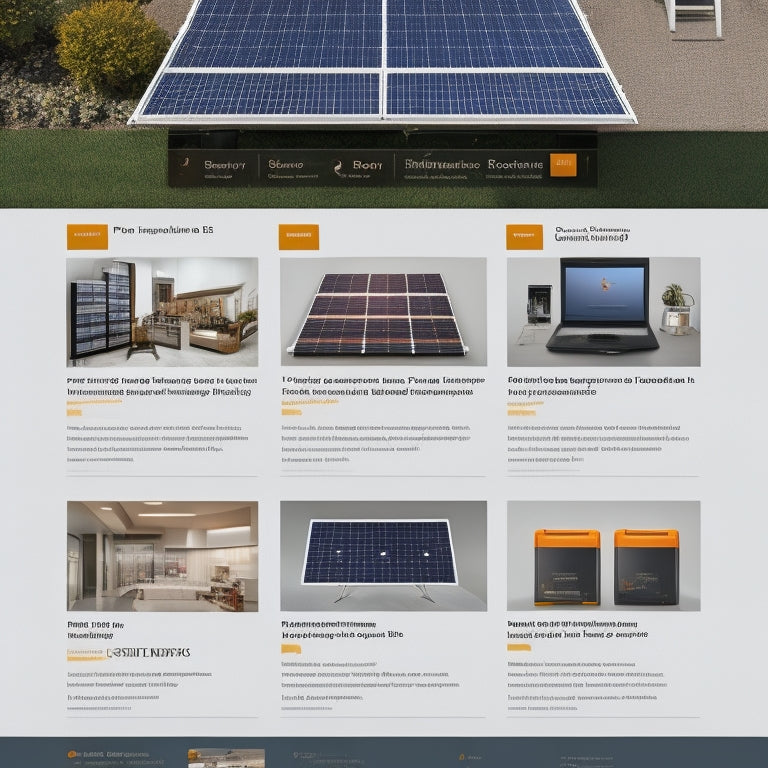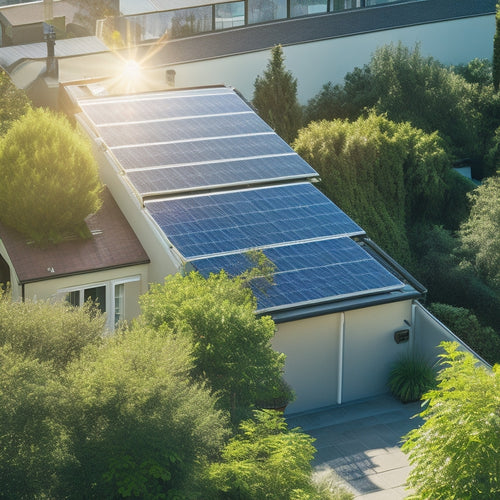
What to Look for in Online Solar Panel Kits
Share
When you're evaluating online solar panel kits, check for key components like photovoltaic panels, inverters, mounting hardware, and wiring. Make sure the kit supports lithium-ion batteries for efficient energy storage. Look at the wattage rating for electricity generation capacity, and prioritize high-efficiency panels, particularly those with PERC or bifacial technologies. Scrutinize warranty terms, particularly for panels and inverters. Opt for kits with clear installation guides and reliable customer support. Consider brand reputation through user reviews. Lastly, analyze cost metrics like cost per watt, financing options, and shipping policies for financial feasibility. Stay tuned to gain deeper insights into these considerations.
Key Takeaways
- Ensure battery compatibility, especially with lithium-ion options, for efficient energy storage and longevity.
- Prioritize high-efficiency panels (over 22%) for maximum energy output, particularly in limited space or low-light conditions.
- Check warranty terms, focusing on length and specific inclusions for panels, inverters, and mounting hardware.
- Look for kits with clear installation guides, safety protocols, and access to 24/7 customer support.
- Read authentic user reviews and evaluate the brand's reputation for reliability and customer service responsiveness.
Kit Components
https://www.youtube.com/watch?v=khYZTmm7S5I
A typical online solar panel kit includes photovoltaic panels, inverters, mounting hardware, and essential wiring components to set up a complete solar power system. When you're selecting a kit, it's important to take into account battery compatibility. Not all kits are designed to work seamlessly with every type of battery, so verifying compatibility can prevent future headaches and additional costs. Look for kits that support lithium-ion batteries, as they offer superior energy storage efficiency and longer lifespan compared to lead-acid batteries.
Mounting hardware plays a significant role in the ease and durability of your installation. High-quality mounting hardware ensures that your panels are securely attached to your roof or ground mount, optimizing energy capture and withstanding harsh weather conditions. Adjustable mounts can provide the flexibility to angle your panels for maximum sun exposure, boosting your system's efficiency.
Inverters are another key component, converting the direct current (DC) produced by your solar panels into alternating current (AC) usable by your home appliances. Some kits offer micro-inverters for each panel, which can increase system resilience and simplify troubleshooting. Making sure these components are included and compatible will set you on the path to energy independence.
Energy Output
Understanding the energy output of your online solar panel kit is essential for determining its ability to meet your household's power needs. You need to analyze the wattage rating, which indicates how much electricity the panels can generate under ideal conditions. Look for kits that provide detailed specifications, including daily kilowatt-hour (kWh) estimates, to gauge their real-world performance.
Consistent output is important for reliable energy supply. Variations in weather conditions and shading can impact performance, so choose a kit designed to minimize these fluctuations. Advanced technologies, such as Maximum Power Point Tracking (MPPT), optimize the energy harvest even in less-than-ideal conditions, ensuring steady output consistency.
Energy storage is another crucial factor. A robust battery system can store excess energy generated during peak sunlight hours, making it available when production dips, like during nighttime or cloudy days. Evaluate the battery's capacity and cycle life to make sure it aligns with your consumption patterns.
Panel Efficiency
When evaluating solar panel kits, you'll need to take into account panel efficiency, which is measured by the energy conversion rate. High-efficiency panels convert more sunlight into electricity, making them essential for peak performance, especially in limited space.
Additionally, evaluate how well these panels perform in low-light conditions to guarantee consistent energy output throughout various weather scenarios.
Energy Conversion Rate
Efficiency ratings of solar panels, often measured as the energy conversion rate, are essential in determining how effectively sunlight is converted into usable electricity. The energy conversion principles behind photovoltaic technology play a critical role in this process.
When you're evaluating online solar panel kits, you'll want to look for panels with higher efficiency ratings, typically expressed as a percentage. Higher efficiency panels convert more sunlight into electricity, maximizing your energy output and reducing the number of panels needed for your system.
Modern photovoltaic technology has pushed the boundaries of energy conversion rates. Standard monocrystalline panels usually offer efficiency rates between 15% and 20%. However, advanced options, like bifacial or PERC (Passivated Emitter and Rear Cell) panels, can achieve rates above 22%. Keep an eye on these figures as they directly impact your system's performance and overall cost-effectiveness.
In your quest for energy independence, choosing panels with high efficiency ratings means you'll get more power from every square meter of installed panels. This is especially important if you have limited roof space but want to maximize your energy production.
Understanding these energy conversion principles ensures you make an informed decision, freeing yourself from conventional energy sources.
Performance in Low Light
Solar panel efficiency in low light conditions can greatly impact your system's overall performance and energy yield. You need panels that perform well in cloudy conditions or shaded areas to maximize energy production. Look for panels with high-efficiency ratings, often indicated by a higher percentage of sunlight conversion even under less-than-ideal lighting.
Monocrystalline panels typically outperform polycrystalline ones in low light due to their higher silicon purity. For instance, while polycrystalline panels might operate at 70-80% efficiency in cloudy conditions, monocrystalline panels can achieve upwards of 85-90%. This difference can significantly impact your energy output over time.
Advanced technologies like PERC (Passivated Emitter and Rear Cell) and bifacial panels also boost performance in shaded areas. PERC cells utilize a rear layer to capture more sunlight, while bifacial panels harness light from both sides, increasing efficiency by up to 30% in partially shaded environments.
When evaluating online solar panel kits, scrutinize the datasheets and look for metrics like the 'low-light performance' or 'temperature coefficient.' These indicators will provide insights into how well the panels perform when the sun isn't shining brightly. By prioritizing high-efficiency panels, you secure consistent energy production, giving you the freedom to rely less on traditional power sources.
Warranty Terms
When evaluating solar panel kits online, you should scrutinize the warranty terms, focusing on coverage length and specific inclusions and exclusions. Most reputable manufacturers offer a 25-year performance warranty, but you need to understand what aspects are covered.
Be aware of any exclusions such as installation errors or environmental damage, which can impact your long-term investment.
Coverage Length Details
For long-term reliability, most online solar panel kits come with extensive warranty terms that typically cover performance and workmanship for 25 years. This extended coverage ensures that you can confidently conduct a durability evaluation and manage maintenance requirements effectively over the system's lifespan. The warranty terms often split into two distinct categories: performance warranty and workmanship warranty.
| Warranty Type | Coverage Length |
|---|---|
| Performance Warranty | 25 years |
| Workmanship Warranty | 10-12 years |
| Inverter Warranty | 5-10 years |
Performance warranties generally guarantee that your solar panels will produce a certain percentage of their rated power output over the 25-year period. This ensures that you won't face significant declines in energy production, aligning with your desire for liberation from unreliable energy sources. Workmanship warranties, on the other hand, cover any defects related to the materials or construction of the panels.
When evaluating the durability and maintenance requirements of your chosen solar panel kit, these warranty terms play an important role. They not only provide peace of mind but also reduce long-term operational costs. With solid warranty terms, your investment in solar energy becomes a more reliable and sustainable choice, paving the way for energy independence.
Inclusions and Exclusions
Understanding the inclusions and exclusions of warranty terms allows you to fully grasp what aspects of your online solar panel kit are protected and where potential out-of-pocket expenses might arise. When evaluating warranties, pay close attention to which components are covered. Typically, panels, inverters, and racking systems are included, but specifics can vary.
Inverter type, whether it's a microinverter or a string inverter, often has different warranty periods and coverage specifics. Microinverters might come with a longer warranty but make sure you check if labor costs for replacements are included.
Battery options also greatly impact warranty terms. For hybrid systems incorporating energy storage, verify if the warranty covers the battery's capacity retention over time. Degradation rates can affect performance, and knowing the specifics can save you money. Some warranties exclude certain types of wear and tear or require regular maintenance for validity—details you'll need to scrutinize.
Moreover, geographical exclusions are sometimes hidden in the fine print. Confirm the warranty applies in your location. By meticulously analyzing warranty terms, you empower yourself to make an informed decision, optimizing both cost-efficiency and system longevity. Don't let hidden clauses restrict your financial and operational freedom.
Installation Guides
Installing your online solar panel kit requires careful adherence to detailed instructions to guarantee peak performance and safety. You'll want to make sure the kit provides thorough step by step instructions that cater to both novice and experienced installers.
Clear diagrams are essential; they should illustrate the arrangement of photovoltaic cells, wiring connections, and inverter placement with precision.
A well-documented installation guide empowers you with the knowledge to maximize energy capture and enhance your system's efficiency. Look for guides that outline the necessary tools and equipment, as well as safety protocols like grounding and circuit protection.
Properly labeled components and wiring diagrams streamline the installation process, reducing the likelihood of errors that could affect system performance or pose safety risks.
Utilizing data-driven insights, these guides should reference industry standards and best practices, ensuring your setup aligns with regulatory requirements. Detailed troubleshooting sections can be invaluable, offering solutions to common issues you might encounter during installation.
Customer Reviews
After meticulously setting up your solar panel kit with the help of a detailed installation guide, it's important to examine customer reviews to gauge real-world performance and user satisfaction. Authentic reviews provide invaluable insights into the kit's efficiency, durability, and ease of use.
When sifting through reviews, prioritize those that offer detailed accounts of long-term usage and specific scenarios. Look for feedback patterns that highlight recurring issues or praises, as these can indicate common experiences that may align with your own needs.
To confirm review authenticity, cross-reference feedback across multiple platforms. Websites like Amazon, specialized solar forums, and even social media can give you a broader perspective. Pay close attention to reviews that include technical data such as kilowatt-hours produced, battery life, and system efficiency under various weather conditions. This information can help you make an informed decision based on empirical evidence rather than marketing claims.
Moreover, consider the diversity of reviewers. Feedback from both experts and novices can offer a well-rounded view of the product's performance. Ultimately, customer reviews are a critical component in your decision-making process, providing a realistic snapshot of what you can expect from your solar panel kit.
Brand Reputation
Evaluating a brand's reputation in the solar industry involves scrutinizing their history, customer service responsiveness, and market standing to guarantee reliability and quality. Start by researching the brand's longevity in the industry. Established brands with years of market presence usually offer more reliable products.
Next, assess their customer service. Brands with prompt and effective customer support can greatly ease the installation process and provide timely troubleshooting, which is essential for maintaining an uninterrupted energy supply.
Look at third-party reviews and industry reports. High ratings in these areas often indicate strong performance and customer satisfaction. Check for certifications and industry accolades, as these can validate a brand's credibility and commitment to quality standards.
Market presence is another critical factor. Brands with significant market penetration often have extensive distribution networks, ensuring better availability of parts and accessories. They also usually offer ample warranties, reflecting their confidence in the product's longevity and performance.
Cost and Financing
When considering the cost and financing of online solar panel kits, it's important to analyze both the upfront costs and long-term savings to determine the most cost-effective option for your energy needs. The initial investment can vary considerably depending on the system's size, efficiency, and brand. Evaluate the cost per watt (CPW) as a metric to compare different kits. Lower CPW often translates to better value.
To ease the financial burden, explore various loan options. Many providers offer solar-specific loans with competitive interest rates and flexible terms. These loans can spread the cost over several years, making the initial outlay more manageable. Additionally, some companies present zero-down payment plans, allowing you to start generating energy savings immediately without a hefty initial expense.
Don't forget to investigate potential incentives and rebates that can further reduce costs. Federal tax credits, state incentives, and utility rebates can significantly lower the overall expenditure. By leveraging these financial mechanisms, you'll accelerate your return on investment and enjoy the freedom of reduced energy bills sooner.
Shipping Policies
Understanding the cost and financing options, you'll also need to scrutinize the shipping policies of various online solar panel kit providers to guarantee timely and secure delivery. The delivery options offered by these providers can greatly impact your project's timeline and budget. Look for companies that offer expedited shipping methods, as well as standard ones, to accommodate any urgent installation needs.
Evaluate the shipping costs carefully; some providers may include it in the total cost of the kit, while others might charge it separately. This can make a substantial difference in the overall expense. Providers with transparent tracking systems offer an added layer of assurance, allowing you to monitor your shipment in real-time.
Return policies are equally critical. A robust return policy ensures that you can easily return or exchange components if they arrive damaged or don't meet your specifications. Check if the provider offers hassle-free returns with pre-paid shipping labels and minimal restocking fees. Additionally, verify the time frame within which returns are accepted, as this can vary significantly between companies.
Technical Support
Robust technical support is crucial to guarantee the seamless installation and efficient performance of your online solar panel kit. When evaluating technical support, prioritize availability hours and service quality. Top-tier providers offer 24/7 support, ensuring you can resolve issues anytime, whether it's during initial setup or ongoing maintenance. High service quality translates to knowledgeable representatives who can provide precise, data-driven solutions quickly.
Consider the following factors when evaluating technical support:
| Factor | Description |
|---|---|
| Availability Hours | Make sure the support team is available around the clock to address any technical issues immediately. |
| Response Time | Look for providers who guarantee rapid response times, minimizing downtime. |
| Expertise Level | Verify that the support team has extensive training and experience in solar technology. |
| Communication Channels | Multiple channels (phone, email, live chat) provide flexibility in how you seek help. |
| User Reviews | Check customer feedback for insights into the real-world service quality of the support team. |
Frequently Asked Questions
How Do I Determine the Best Placement for Solar Panels on My Property?
To determine the best placement, perform a shading analysis, evaluate roof orientation, and assess average sunlight hours. Maximize efficiency by ensuring minimal shading, ideal south-facing orientation, and sufficient sunlight exposure. Embrace energy independence through strategic positioning!
Are There Any Local Incentives or Rebates Available for Solar Panel Installations?
Yes, you should research local incentives and rebate programs available for solar panel installations. Many regions offer tax credits, grants, or performance-based incentives to reduce upfront costs and enhance your investment's return on energy independence.
What Are the Typical Maintenance Requirements for Solar Panel Systems?
Did you know that well-maintained solar panels can boost efficiency by up to 20%? You should clean them bi-annually and use monitoring equipment to track performance, ensuring your system operates at peak levels consistently.
How Do Solar Panels Perform in Different Weather Conditions?
You'll notice solar panels excel in sunny weather, but they still perform in cloudy conditions, producing around 10-25% of their capacity. Seasonal performance varies; winter reduces efficiency due to shorter daylight hours and potential snow coverage.
Can I Expand My Solar Panel System in the Future?
Yes, you can expand your solar panel system in the future. Guarantee system compatibility and future scalability by choosing modular components and checking inverter capacity. Liberation from grid dependency requires forward-thinking planning and technical precision.
Related Posts
-

Solar Power Systems for Cost-Effective Sustainability
Investing in solar power systems is a smart move for cost-effective sustainability. You can save about $1,500 annuall...
-

How Solar Panels Reduce Electricity Bills
Solar panels can drastically cut your electricity bills by utilizing sunlight to generate your own energy. This decre...
-

Solar Power Backup Solutions During Outages
Solar power backup solutions guarantee you have reliable energy during outages, providing essential power when the gr...


